With over 500 species of spiders in Michigan, there is no shortage of fascinating species to encounter. The state has its share of the eight-legged crawlers, but most are completely harmless. We have put together a list of spiders you are most likely to see in the State of Michigan
There are two types of spiders you’re likely to find in the State of Michigan: Dangerous and harmless spiders. The spiders to look out for are:
- Northern Black Widow – Dangerous
- Brown Recluse – Dangerous
- Yellow Sac Spider – Dangerous
- American House Spider – Harmless
- Cross Orb-Weaver – Harmless
In this article we will take a closer look at the characteristics of each of these spiders and when you are likely to see them.
Dangerous Spiders In Michigan
1. Northern Black Widow
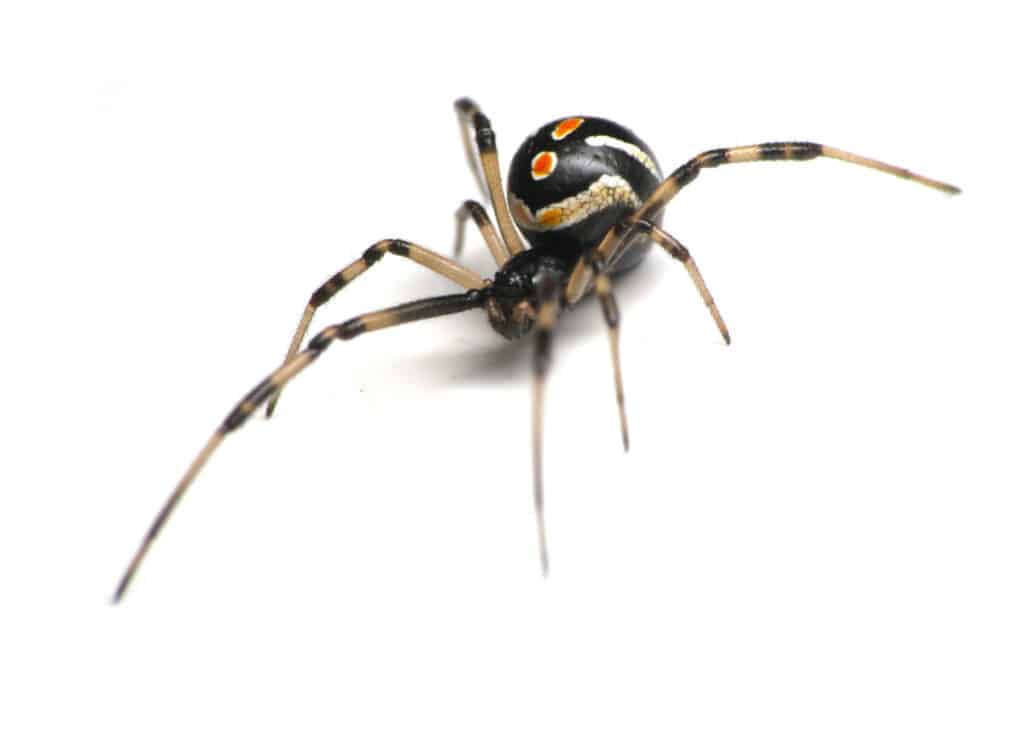
Northern Black Widow: Scientific Name
Latrodectus various.
Northern Black Widow: Bite And Venom
A bite from the female is usually more dangerous and merits a visit to a physician. While Northern black widows are venomous, they are not aggressive. They only bite as a defensive mechanism, like when you turn over the log they are hiding under.
Males are generally harmless.
Northern Black Widow: When You Will See Them
These black widows tend to be territorial and solitary, and they are active during the spring and summer months when temperatures are around 70 degrees. They lay their eggs during summer, and the eggs hatch two to four weeks later. But out of a sac of 20 to 900 eggs, only two spiderlings survive because the adults cannibalize the rest.
They are nocturnal spiders meaning they hunt at night. During this time, they build their irregular webs near the ground to catch more crawling insects.
Northern Black Widow: Size And Color
As its name describes it, this spider is black, and it belongs to the widow spiders family, so close relatives include the Western and Southern black spiders. The Northern Black Widow spider has a distinctly broken hourglass on its back and a glossy abdomen.
The broken hourglass distinctly differentiates it from the Southern black widow. The males are brown with yellow or red bands on the back. The female is also larger at about 1.5 inches, while the male is nearly half the female’s size.
Northern Black Widow: Diet And Feeding Habits
These spiders tend to hide from people and are active at night. At night they trap mosquitoes, caterpillars, and beetles in their messy web and feed on them.
They lay their eggs in crevices under logs and stones. They also find shelter in secondary buildings like barns and tool sheds, but they are not considered pests. Northern black widows love these buildings because they are attracted to dark places that are quiet with lots of places to hide out ready to ambush their prey.
Northern Black Widow: Life Cycle
After the Northern black widow female lays her eggs, there is an incubation period of 20 days. The spiderlings have a three-month period to grow while older females die in autumn after laying their eggs.
A Northern black widow spider can live for up to three years.
2. Brown Recluse
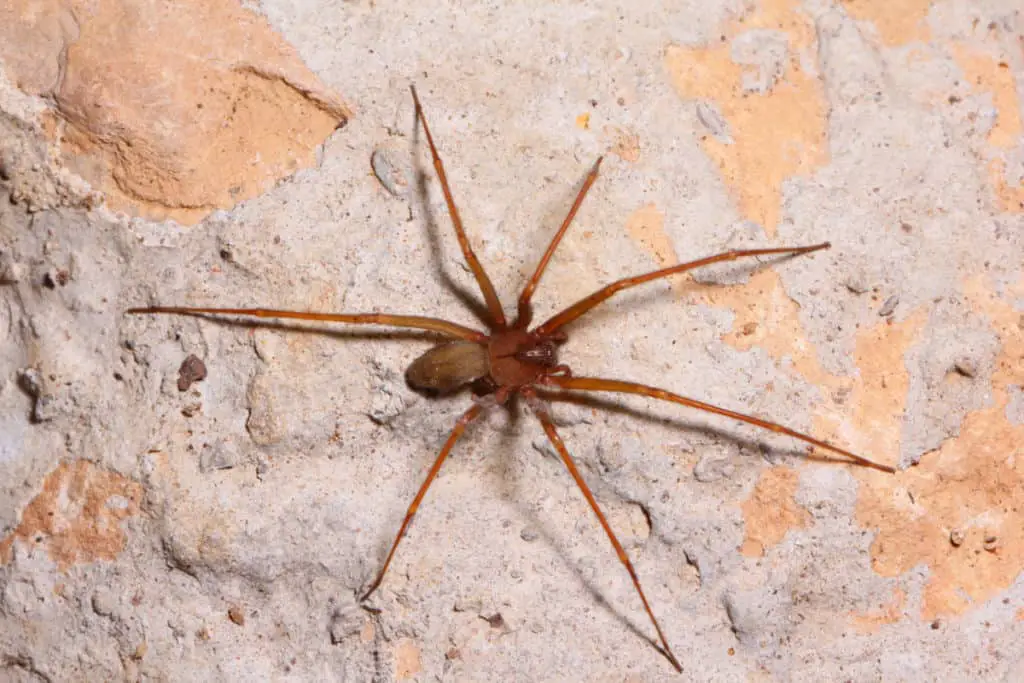
Brown Recluse: Scientific Name
Loxosceles Reclusa.
Brown Recluse: Bite And Venom
Both the males and the females have venom, but the venom from the female is more toxic. However, males tend to bite people more because they roam about more than females. The male bite injects half as much venom as its female counterpart, which explains why their bites are considered less severe. Brown recluse spiders’ venom can be deadly.
Like Northern Black Widows, they do not seek out humans to bite. They can even co-exist with you in your home, but their bite is venomous.
Brown Recluse: When You Will See Them
These spiders are a rare find in Michigan because they live in isolated populations. In the areas where they live in groups, you can find a population of these spiders in all stages of life. Brown recluse spiders are only active between March to October, which is spring to early autumn.
They are nocturnal spiders, but hunger and overcrowding can make them diurnal as well. This means you can see them crawling around on the walls and ceiling, hunting for food.
Brown Recluse: Size And Color
Males are smaller in length compared to their females, but they have longer legs. A female may be ½ an inch in size, and a male is typically ¼ of an inch. Both are either dark brown or tan, and they have a violin shape on their backs.
Brown recluse spiders have a more elongate body with long tapering legs.
Brown Recluse: Diet And Feeding Habits
Brown recluses are scavengers of sorts that are happy to feed on the carcasses of already dead insects. But they also attack living insects like grasshoppers and mosquitoes for a meal. These spiders do not build webs to capture prey but to hold their eggs. They hide and stalk their prey at night.
They are considered a household pest because they can populate in your home.
Brown Recluse: Life Cycle
An adult recluse can live for one to two years. Between May and July, the females lay eggs in /3-inch silken egg sacs, and the eggs hatch after four weeks. The spiderlings grow to maturity within one year.
3. Yellow Sac Spider
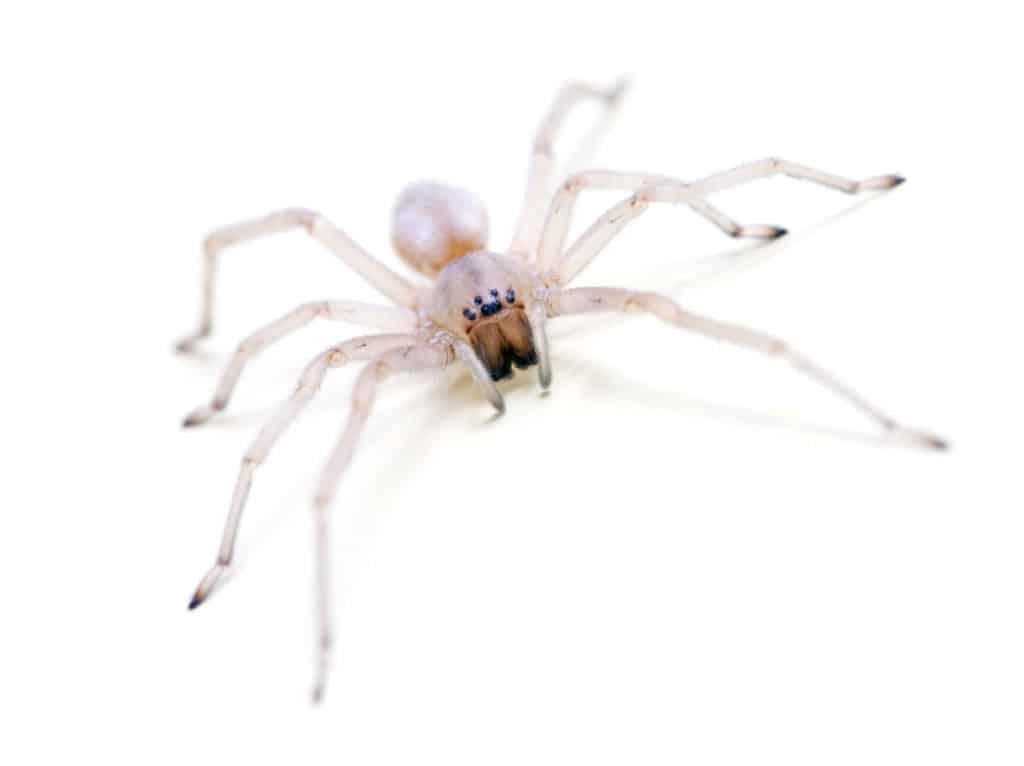
Yellow Sac Spider: Scientific Name
Cheiracanthium Mildei
Yellow Sac Spider: Bite And Venom
Their bite is super painful, almost like being stung by a hornet. It is typically followed by swelling and redness, but the venom can react with your skin and cause blisters that become sores or necrotic lesions.
The venom can also make you ill and cause edema or erythema. Unfortunately, most of the spider bites presented in hospitals in Michigan and around the country, are by yellow sac spiders.
Yellow Sac Spider: When Will You See Them
They are most active during spring, summer, and autumn. Autumn is when they lay their eggs, which hatch, and the spiderlings mottle into adults that show up between April and November.
The females lay their eggs and cover them in silk spun coats. Their eggs are hidden in places you normally don’t frequent, like on the ceiling, behind pictures, and along the back of shelves.
As you can see, these are areas in the house, meaning that while yellow sac spiders are outdoor spiders, they like to come into the house, making them dangerous pests.
In the outdoors they lay their eggs on the underside of leaves or under foliage.
Yellow Sac Spider: Size And Color
They are yellow with a tinge of green in color. Females range between 5-10 mm in size while the males are slightly smaller at 4-8 mm. It is very hard to tell a male and female apart based on size and coloration because they are so similar.
Yellow Sac Spider: Diet And Feeding Habits
Yellow sac spiders don’t build webs but are active hunters. These spiders wave their front legs in front of them during hunting. They are nocturnal, and they feed on other smaller and big spiders as well as insects.
Yellow Sac Spider: Life Cycle
Female yellow sac spiders lay their eggs in June and July. After a month, the eggs hatch, but the spiderlings remain in their silken spun coat until they are old enough to hunt for themselves. They venture out of their enclosure to go and hunt at night but retreat at daybreak. These spiders live for at least a year.
Harmless Spiders
4. The American House Spider
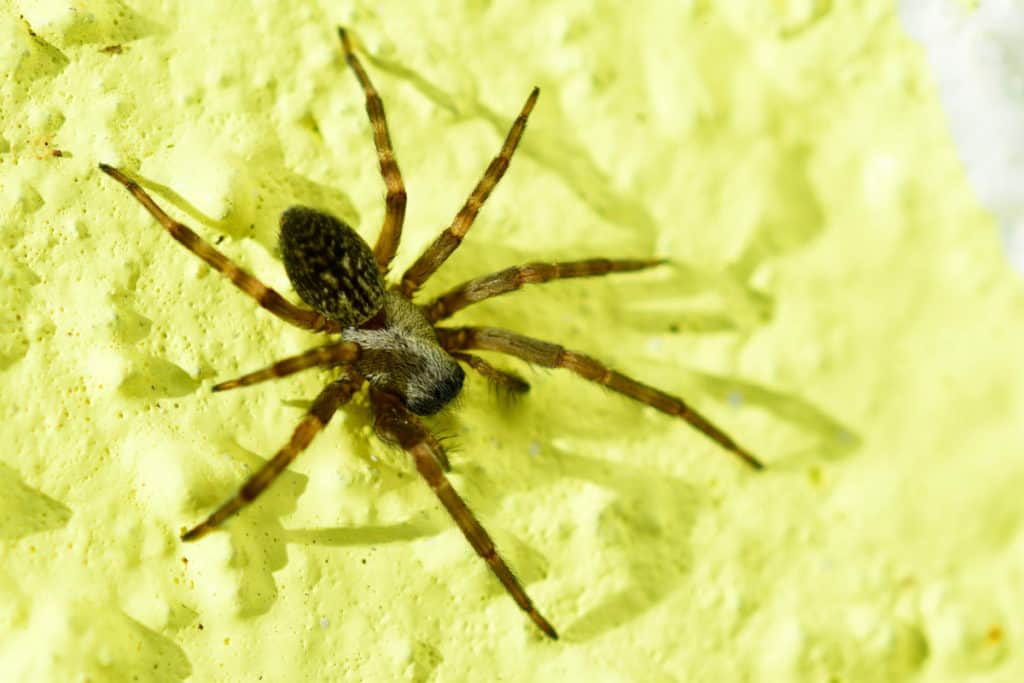
American House Spider: Scientific Name
Parasteatoda Tepidariorum
American House Spider: Bite And Venom
The American house spider is not venomous, but it can bite. Their most severe bite feels like a bee sting, and it may cause mild swelling and redness but nothing serious. The pain and discomfort tend to subside within a few hours without needing medical attention.
American House Spider: When You Will See Them
They are nocturnal spiders that leave behind a mess of cobwebs in places like the basement, closet, and other storage areas. American house spiders are very active during summer and autumn and tend to decrease their winter activity levels. The slowing downstate is known as diapause, but they are not completely inactive.
They emerge periodically to look for prey, especially on warmer days.
American House Spider: Size And Color
These spiders are generally brown with speckled patterns and patches on the legs. They do not tend to have very distinguishing marks to set them apart.
Males grow to reach around six mm, which is equivalent to 1/5 of an inch. On the other hand, females can grow up to 10 mm, which is around 1/3 of an inch. American house spiders also have a bulbous abdomen and tapering legs.
American House Spider: Diet And Feeding Habits
American house spiders feed on insects like ants, flies, mosquitoes, and wasps. They are actually good for the environment because they naturally control pests in the house. Their tangled cobwebs trap the insects. Grasshoppers, roaches, and butterflies are also fair game for these spiders.
If you are interested in finding out more about which spider will eat roaches check out this article we have written, Do Spiders Eat Roaches?
American House Spider: Life Cycle
Females lay their eggs in a pear-shaped papery case that hangs from the web. After three to four weeks, the eggs hatch, but the spiderlings remain on the web for a few days before dispersing. They can live for at least a year.
For more on how long these spiders live check out this article we have written, How Long Can Spiders Live Without Food? You will also find out which spider can live for decades.
5. Cross Orb-Weaver
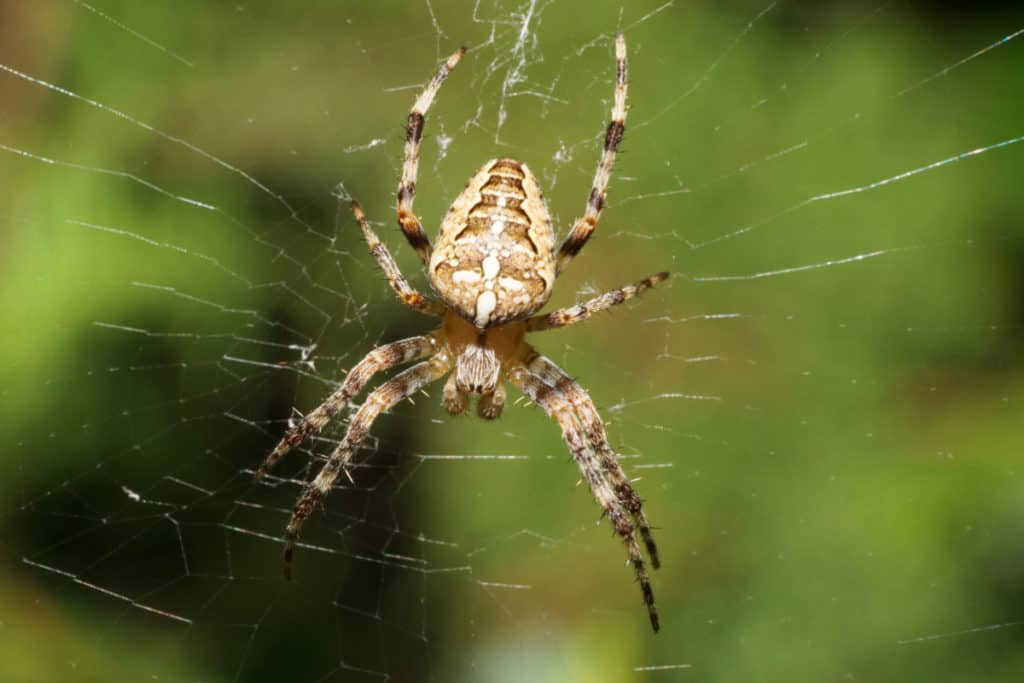
Cross Orb-Weaver: Scientific Name
Araneus Diadematus
Cross Orb-Weaver: Bite And Venom
The Cross Orb-weaver spider belongs to the group of spiders with very low venom toxicity. In fact, not only is their bite not dangerous to humans, they seldom bite. This non-aggressive spider may bite if trapped against your skin and only in defense, but the bite is like a mild bee sting.
Cross Orb-Weaver: When You Will See Them
These spiders are very active around light fixtures, or when outdoors, you can see their activity on tree branches or grasses. They are both nocturnal and diurnal spiders meaning they can be active at night and during the day.
You will notice more adults in the summer and fall months as they reach maturity. You are likely to encounter this spider both outdoors and indoors, but they are not your typical pests.
Cross Orb-Weaver: Size And Color
Unlike other species like the black widows, the Cross orb-weaver spider male is not significantly smaller than the female. The female is between 6-20 mm, and the male is closely behind, measuring between 6-13 mm.
However, the female has a distinct round abdomen.
Their coloring ranges from orange to brown or light yellow and, in some cases, even dark grey. Regardless of their coloring, they all tend to have mottled markings across the back, forming some sort of cross, earning them the name Cross orb weaver spiders.
Cross Orb-Weaver: Diet And Feeding Habits
Cross orb-weaver spiders love a meal of small flying insects like mosquitoes and flies. They weave a complex orb web of around 40 cm in diameter. As the insects fly around, they find themselves trapped in the web and entangled.
The large females build these webs late at night.
For a full guide to the diets of different species of spiders (some eat birds), you might be interested in this article we have written, What Do Spiders Eat?
Cross Orb-Weaver: Life Cycle
These spiders live for about 12 months. They mature in summer when they mate and lay a new batch of eggs. But after laying eggs, they die off. The spiderlings move around by ballooning and floating on a light breeze to go and form their own webs.
How To Treat A Spider Bite
You can treat a spider bite at home if you deal with a harmless spider like the cross orb weaver or the American house spider.
You will typically be dealing with mild skin irritation, swelling, redness, and some pain.
- Begin by wiping the site of the bite with some warm water and antiseptic to clean it
- Apply an ice pack to reduce the swelling. It is best to use the ice pack on and off
- If there is an itching sensation on the bite site, consider taking an antihistamine
- Monitor the bite to ensure it does not become infected
If you have been bitten by a black widow, a brown recluse, or a yellow sac spider, it is best to go to the hospital. It is crucial to monitor your symptoms so that you can help your doctor administer the right medication to counter their venom.
The Wrap Up
Of the 500 species of spiders in Michigan, only the three mentioned above in the dangerous section are medically relevant. The rest are both indoor and outdoor spiders that happily live without interfering with human beings. The American house spider and the Cross orb weaver spiders are the most commonly occurring harmless spiders.
Next time you see a spider in Michigan, don’t panic. It most likely will hide away from you. But if you have an infestation and can’t identify the species, call in the exterminator.
Sources
https://www.insectidentification.org/insect-description.asp?identification=Northern-Black-Widow
https://earthsky.org/earth/10-things-to-know-about-brown-recluse-spiders
https://www.onlinepestcontrol.com/yellow-sac-spider/
https://animalcorner.org/animals/yellow-sac-spider/
https://entomology.ca.uky.edu/ef631
https://www.livescience.com/49333-why-black-widow-spider-venom-is-so-potent.html
https://uwm.edu/field-station/cross-orbweaver-spider/
https://www.mayoclinic.org/diseases-conditions/spider-bites/diagnosis-treatment/drc-20352377
https://www.healthline.com/health/spider-bites
https://www.ncbi.nlm.nih.gov/books/NBK537045/
https://www.livescience.com/49333-why-black-widow-spider-venom-is-so-potent.html
